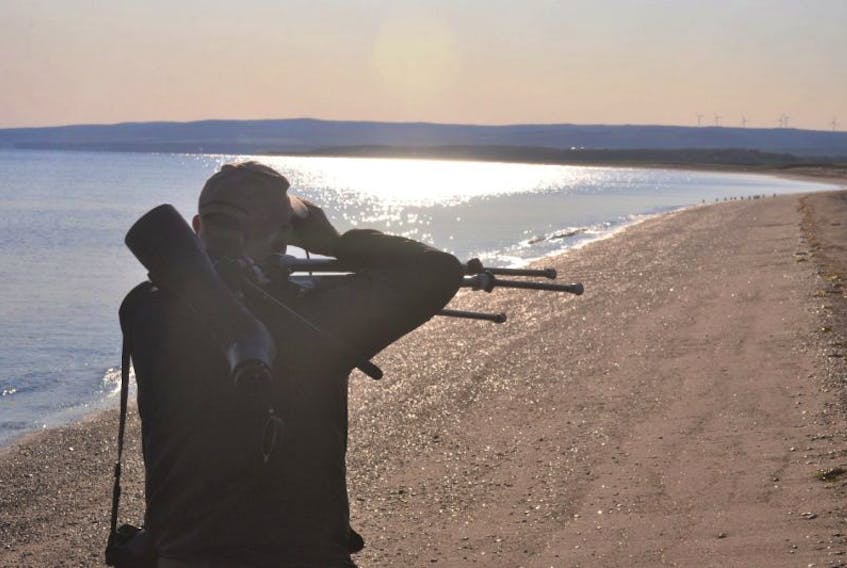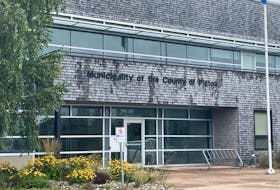Ken McKenna parks his Honda CRV beside the road and makes his way along a narrow path lined with plants careful to watch out for poison ivy.

He steps onto the beach, raises his binoculars and searches the sand for small signs of movement.
Finally he sees them.
A small group of piping plovers barely visible to the naked eye, their small bodies blending into the beach.

The endangered bird is struggling for survival, and volunteers like McKenna have devoted parts of their summers to monitor the birds and their nests to help protect them.
They are part of a larger effort known as the Nova Scotia and New Brunswick Piping Plover Conservation Program begun in 2006 to help address the problem.
Some of the actions as part of the conservation efforts have taken include putting up signs advising people where nests are, fencing areas in higher traffic beaches and encouraging people to keep their dogs on leashes in areas known to be nesting areas.

Already it’s made a difference. Since the program began in 2006, Nova Scotia's plover population has increased by 20 per cent. But even eliminating the human and domestic dog interference with nesting, there are still lots of natural hazards affecting the nests. Preliminary data shows that of the 52 nests initiated by piping plovers in Nova Scotia this year, 24 failed.
Southern Nova Scotia particularly saw a large number of nest failures with everything from weather to predators to blame.
Pictou County, in contrast has had a more successful year. There were four known nests in the county this year with three on Big Island, making it one of the most concentrated nesting areas in the province. Out of those four nests, nine young were successfully raised.
One pair of plovers set up near an area frequented by beach goers. Volunteers roped it off with signs asking people to give the plovers their privacy.
But a storm surge hit the day before the eggs were supposed to hatch.
“You could see in the morning, the seaweed was about a metre above the nest,” McKenna said. None of the chicks survived.
At another area on the beach another nest was set up. From this one chick hatched. A second was found dead in its egg with a small hole where it had started but failed to hatch. McKenna suspects that maybe the storm surge that damaged the other nest also had an impact on this one.
The third nest was the most successful with four chicks hatched. All appear to have survived.
A fourth nest was also monitored near Black Point where four more are believed to have successfully hatched.
McKenna said that the majority of the parents and babies were tagged by the Canadian Wildlife Service and will be studied in the years to follow.
Piping Plovers migrate each year from Nova Scotia down to the Southern U.S. and Caribbean Islands, he said. A large number have also been recorded in the Bahamas.
With the young fledglings now able to fly on their own, the females at most sites have already left for warmer climates. The males will stick around to watch over the young for a time before heading south. The ones hatched this year, will follow after that, finding their own way.
“I’m not sure how that happens – how they’re able to find their way down south on their own,” McKenna said. “Towards the latter part of July most will be gone.”
Because of the tagging program, next year they will be able to see if any of the ones that were on Big Island this year return.
Ideally, they’d like to see the number of pairs increase to 60 in Nova Scotia. That wouldn’t bring them out of their endangered status, but would add some stability.
Rielle Hoeg, was hired by Bird Studies Canada to monitor the northern zone of Nova Scotia this year. Big Island was the only beach she found with three pairs nesting. While she kept track of the birds, she kept her distance, only going close enough to the nest once to count the eggs.
“People approaching nests is a big no-no,” she said, explaining that sometimes the parents will abandon a nest if they’re disturbed too much.
She believes that the piping plovers can have a future in Nova Scotia, but it will take the co-operation of residents to make it happen.
While many people were willing to listen to her advice, others continued to allow dogs to run off leash. Signs at some sites advising of the nesting area were even pulled out.
“I feel like we need to get a bit more awareness and education,” she said.
The future of the piping plover depends on it.









